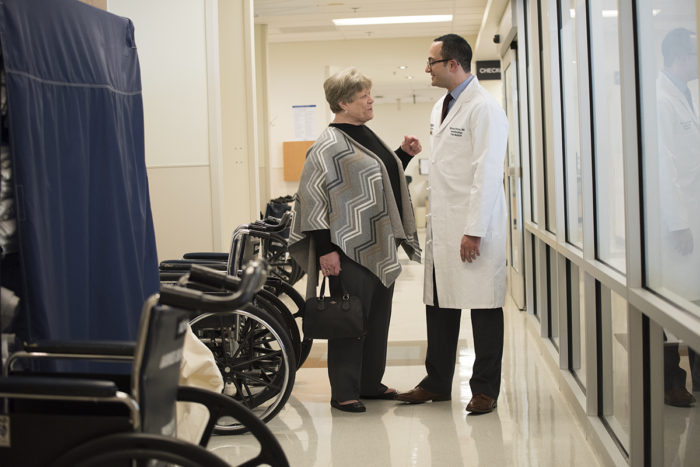Spinal cord stimulation relieves back pain without opioids
New approaches can help in battling opioid abuse
 Robert Boston
Robert BostonBack pain patient Deanna Conley (left), talks to Michael Bottros, MD, at the Washington University Pain Center at Barnes-Jewish Hospital. Prior to the implantation of a high-frequency spinal cord stimulator, Conley had used a wheelchair to get to her appointments with Bottros. Since having the device implanted, Conley's level of back pain has been reduced by 70 to 80 percent.

Doctors who treat patients suffering from back pain are exploring new approaches that help some patients avoid opioid drugs. The highly addictive prescription painkillers are fueling an epidemic of abuse and overdose deaths.
One opioid-free option available at the Washington University Pain Center at Barnes-Jewish Hospital involves stimulating the spinal cord with very short pulses of electricity. Patients can’t feel the electrical stimulation, yet it often effectively can mask the perception of pain.
Spinal cord simulation to relieve pain is not new. It first was introduced many years ago, but older stimulators produce a tingling sensation designed to replace pain with less unpleasant tingling. The newer, high-frequency spinal cord stimulators deliver more energy but without the tingling sensations.
Pain specialists at Washington University School of Medicine in St. Louis were involved in clinical trials of the new stimulation devices; in 2015, the FDA approved the devices as a treatment for back pain. Most but not all insurance plans cover treatment.
As many as one in three Americans suffers from low back pain. Its economic impact is greater than that of heart disease and cancer combined.
“Patients have many treatment options, but many don’t get relief after surgery or injections,” said Michael Bottros, MD, an assistant professor of anesthesiology and director of the acute pain service at Barnes-Jewish Hospital. “Opioids can help some patients temporarily, and physical therapy also helps, but the new-generation stimulators fill an important niche, helping people return to normal activity without pain or the side effects that can result from opioids.”
Deanna Conley, 77, of St. Louis County, has endured back pain for years. Despite multiple surgeries, she needed a wheelchair last fall to travel any significant distance. In addition, she began to worry about the number of pain pills she took each day.
“I was supposed to take one hydrocodone pill at night before bed,” Conley said. “But it got to where I was taking two pills a day and then three, and I worried I might end up being a drug addict at 77.”
Bottros determined Conley was a good candidate for a high-frequency stimulator. Studies have shown the devices may be more effective in patients who have had previous back surgery but still have back pain. Research also indicates that although traditional stimulators work well when pain in the back is radiating into arms or legs, the high-frequency stimulators may be more effective when pain is located in the back itself.
“Traditional spinal cord stimulators provide a pleasant sensation in place of pain from sciatica problems or pain down the arm caused by cervical spine problems,” Bottros explained. “But for people like Ms. Conley, who had already had back-fusion surgery and still had pain, those older devices often aren’t as effective.”
Bottros inserted electrodes into the area of Conley’s back where her pain was most acute. The stimulator initially remained outside her back, but after Bottros was able to verify that the approach was having an effect, he used a minimally invasive technique to implant the entire device into the lower part of her back.
In clinical studies, 75 percent of subjects treated with the high-frequency stimulators experienced reductions in pain of at least 50 percent after three months. Conley reported a 70 to 80 percent reduction in back pain almost immediately. She is able to walk without assistance for considerably longer distances than she could before the stimulator was implanted, and she even registered for an exercise class.
She’s receiving physical therapy and getting stronger now that she is able to use muscles she couldn’t use previously because of her back pain.
“It’s important that we use a team approach involving doctors, physical therapists and psychologists who help people focus their thoughts on things other than their pain,” Bottros said. “Even when a device like this reduces pain, there still is muscle weakness to overcome, so patients need physical therapy to get stronger, to make sure they’re walking correctly and to focus on core stabilization to keep the pain in check.”
Physicians at the Washington University Pain Management Center treat patients at the Center for Advanced Medicine (CAM) on the Washington University Medical Campus. Pain-management physicians also see patients at Missouri Baptist Medical Center and Barnes-Jewish West County Hospital.
“Not long ago, we thought of pain as a symptom of some other underlying disease process,” Bottros said. “Now we’re learning that pain also may be a disease itself. And in this time of opioid abuse, we must be vigilant in insisting that pain-killing drugs aren’t overused. Some patients benefit from opioids, but other interventions, combined with a multidisciplinary approach to care, may provide pain management without the side effects and risks associated with opioids.”






